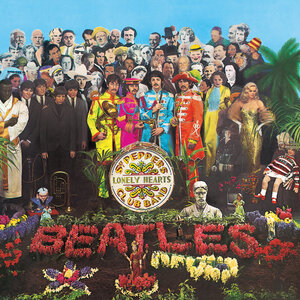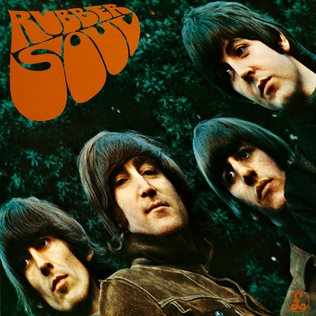Throwback Thursday: Sgt. Pepper's Lonely Hearts Club Band
Everyone knows it. It's only Rolling Stone magazine's listed number one greatest album of all time. It was 46 years, 9 months and 26 days ago today! Sgt. Pepper told the band to play! They've been going in and out of style, and they're guaranteed to raise a smile. 46 years, 9 months and 26 days is the exact duration from when the legendary album was released (June 1st 1967) and today (March 27th 2014). And they certainly have not gone out of style!
The concept came about from an idea Paul had of recording an album as a fictitious band (with the leader supposed to be Sgt. Pepper). The only 'band member' who is actually named is Billy Shears, the pseudonym of Ringo Starr. The opening track shares a title with the album, and it introduces the band before segueing into "With a Little Help From My Friends" and introducing Billy Shears. Paul and John wrote the song specifically for Ringo to sing. However this alter ego concept ended with the opening two songs and the titular reprise second-last on the album. The idea was quickly abandoned and, whilst the remaining songs on the record are extraordinary, they bear no connection to the idea.
The sitar makes an appearance once again with George's sole piece on the album, "Within You Without You". Fun fact: the album was influenced by the Beach Boys' 1966 album Pet Sounds, which itself was influenced by Rubber Soul. This influence can be seen on "Good Morning Good Morning" with the animal sounds. A popular song from the album, "Lucy In the Sky With Diamonds", was written by John about a drawing his son Julian had showed him, contrary to popular belief. The entire lyrics of "Being For the Benefit of Mr Kite!" were derived from an 1843 circus poster that John had purchased from an antiques shop. The track also features a middle of various recording tapes chopped and mixed up to give the whimsical tunes heard. A similar technique was used on Revolver's "Tomorrow Never Knows". Other tracks on the album include "Fixing a Hole", "She's Leaving Home", "Lovely Rita", "Getting Better" and "When I'm Sixty-Four".
Perhaps (or very likely) the most loved and well-known performance, not just from this album but of all Beatles songs, is "A Day in the Life". It has been named the number one Beatles song and number 28 in Rolling Stone's list of greatest songs. The last track on the album, it incorporates a forty-piece orchestra, heard in the middle of the song and on the famous final chord, which rings out for over forty seconds. There are two distinct parts of the song - John's (verses) and Paul's (middle). At the end of the song, amongst random studio chatter, is a very high-pitched dog whistle.
The album cover collage contains around sixty people including Ghandi, Marilyn Monroe, Shirley Temple, Edgar Allen Poe, Sigmund Freud, Lewis Carroll and original bassist Stuart Sutcliffe. Lennon wanted to include Jesus and Adolf Hitler but were ultimately left out of the final product. To the left of the Beatles themselves, you can see wax models of them. There are supposedly various 'clues' on the album sleeve which contribute to the 'Paul is Dead' theory.
Unique to this Beatles album: many many many things.
A Guy in Uruguay
Following on from previous announcements about tours in Costa Rica, Chile, Ecuador and Peru, Sir Paul has now announced another location - Uruguay! It's seems South America are the lucky ones this time around. Maybe he should keep this southern hemispherical theme and move west... there's a very large country with a very large fan base here waiting for you, Paul!
Throwback Thursday: Revolver
Whilst many of the songs are much-loved and well-known (the likes of "Eleanor Rigby" and "Yellow Submarine"), it's the lesser-known, more obscure compositions which exhibited fresh musical techniques and styles. Harrison plays the sitar on his track "Love You To", much like he did the previous year on Rubber Soul's "Norwegian Wood". Harrison also contributed opening track "Taxman" and "I Want To Tell You". Adding to the list of 'firsts' that The Beatles provided to the musical world, Lennon's "I'm Only Sleeping" contains a guitar solo - but not just any guitar solo. Oh no, it's a backwards guitar solo, played by Harrison, created by running the tape backwards. This was a unique technique in 1966. "Tomorrow Never Knows" may be the most experimental one, with the entire song consisting of different random tapes looped and played in odd sequences, with the final result being sounds such as the 'seagull' sound heard throughout the song.
Many are under the impression that drummer Ringo penned the popular "Yellow Submarine" due to his deep baritone vocals dominating the tune. In actual fact, Paul dreamed up the song with Ringo in mind. Of course, the immensely popular single went on to become an animated film and an album for the quartet, released three years later.
The album cover illustration was created by bassist Klaus Voormann, an old friend of the group whom they'd met in their Hamburg days. The artwork is a mixture between line drawings and photo collages. Voormann's name can be seen woven into the right side of Harrison's hair. There are certainly many aspects of Revolver which make it unforgettable, loveable and revolutionary.
Unique to this Beatles album: the album features the first backwards guitar solo, seen on "I'm Only Sleeping"
Paul Does South America
Following on from last year's Out There tour, Sir Paul has recently announced some new tour destinations, set to take place in April this year. This time around Paul is heading south... South America, that is, with concerts lined up in Chile, Peru, Costa Rica and Ecuador. It seems, in typical Paul McCartney fashion (much like last year), the dates and locations are being revealed periodically, usually one at a time. We are anxious to see where he is heading next and if (hopefully) it's on other continents too! Watch this space for more tour information.
Throwback Thursday: Rubber Soul
The sensational sixth album for the even more sensational stars proved to be the start of something new for the group. Rubber Soul was the starting point for the band's new direction. It is the second album to feature only originals, the first being A Hard Day's Night. The record was released on 3 December 1965, only fours months after Help! The album is considered to be folk rock, also incorporating pop and soul styles. The immense success and popularity of this much-loved album is proven by its ranking at 5th on Rolling Stone magazine's "500 Greatest Albums of All Time", trailing only future albums Revolver and Sgt. Pepper's Lonely Hearts Club Band, which would be the band's next two respective albums.
Influences for the music on Rubber Soul include Bob Dylan and The Beach Boys. A key feature that makes this album so revolutionary is a single song - Lennon's "Norwegian Wood (This Bird Has Flown)" featured the sitar, an Indian instrument, played by Harrison. He had been introduced to the sitar whilst filming Help! Thanks to George and his sitar, it is thought that "Norwegian Wood" sparked the craze for Indian rock and raga rock and the distinctive style of the mid-60s.
New and inventive exotic styles can be seen further on the album on tracks such as "Michelle" (which contains French lyrics) and "I'm Looking Through You" (in which Starr taps on a matchbook to create a beat). "In My Life", a Lennon song inspired by his childhood and memories, interestingly features producer George Martin on the piano. Lennon requested for the instrumental piano solo that Martin play something "Baroque-sounding", which proved impossible for Martin to do at the song's current tempo. His piano solo was sped up and made to be an octave higher, giving it sound much like a harpsichord. Harrison's contributions were "If I Needed Someone" and "Think For Yourself". Starr's lead vocals appear on "What Goes On", an early song which is credited to Lennon-McCartney-Starkey.
The photograph on the album cover has a distinctive slope or stretched appearance. This came about when the photographer projected the photos onto a piece of cardboard. When the cardboard fell backwards, the result was what is seen on the cover. The Beatles asked him to make the cover exactly like what they saw. Additionally, it is the first of their albums to not feature their name on the cover, an unusual tactic for 1965.
Unique to this Beatles album: an Indian sitar is played on "Norwegian Wood", introducing non-Western instruments into Western music.
Throwback Thursday: Help!
Help! is the quinary album for the quixotic quartet, and their quirky second film. It was released on 6 August 1965, eight months after previous LP Beatles for Sale. The seven tracks on side one of the vinyl double as the soundtrack to the film. Singles "Help!" and "Ticket to Ride" are found on this side. Across the fourteen tracks, there is a diverse range of music styles exhibited. McCartney-penned "I've Just Seen a Face" can be considered to be country. Bob Dylan's influence on Lennon shows up again in "You've Got to Hide Your Love Away", a composition also found in the film.
Harrison hadn't contributed a song to an album since "Don't Bother Me" on With the Beatles in 1963. The youngest member offers two tracks this time around - "I Need You", which has its own sequence in the film, and "You Like Me Too Much". A stand-out song from this album (though on side two) is "Yesterday", notable for being recorded solely by McCartney and orchestral musicians without the other three Beatles present. The iconic song has since gone on to be the most-covered of all time. In addition, Help! was the last Beatles album to contain any cover songs - "Act Naturally" (which was Starr's vocal contribution) and "Dizzy Miss Lizzy".
The album cover features the four with their arms spelling out a word in flag semaphore. The idea was to have "HELP" spelled out, however when the cover was photographed, the four letters did not look appealing. The end result, found on the cover, does not spell out anything (it actually spells NUJV) - it was chosen simply for its graphic appeal. The outfits worn on the cover are from a sequence in the film where they are playing around in the snow and during the "Ticket to Ride" sequence.
The feature film, which was released on 29 July, was directed by Richard Lester, who also directed the group's first film A Hard Day's Night. It was filmed entirely in colour, with locations for filming including the Swiss Alps and the Bahamas.
Unique to this Beatles album: it is the last album to feature cover songs - "Dizzy Miss Lizzy" and "Act Naturally" (though Let it Be's "Maggie Mae" is an exception).
Subscribe to:
Posts (Atom)




